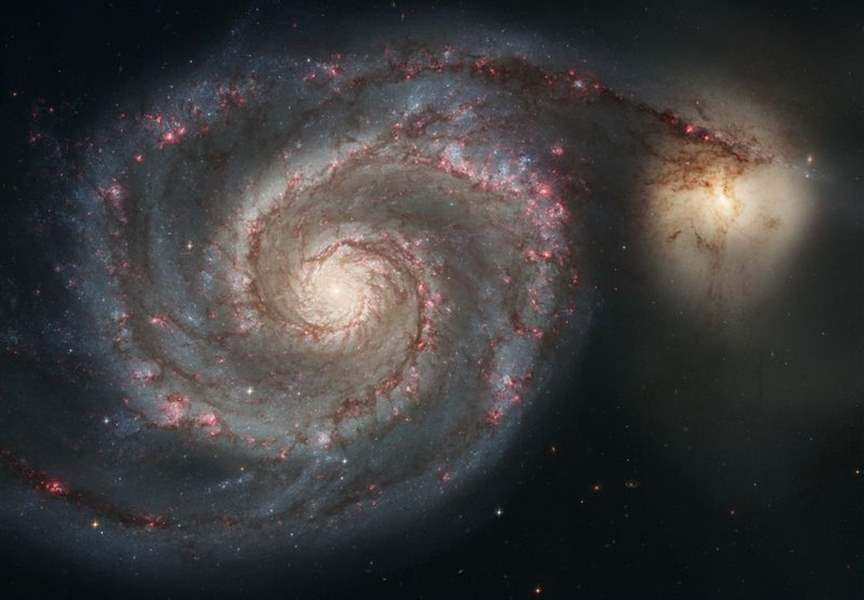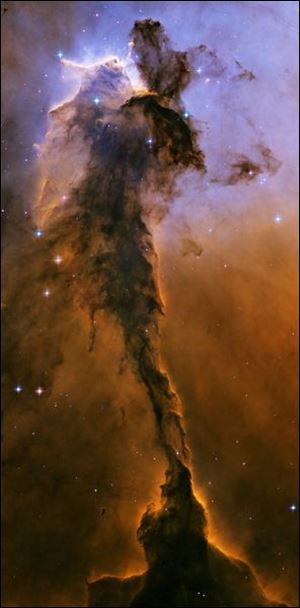
<font face="verdana" size="1" color =#CC0000><b>* New * </b></font> Hubble Space Telescope photos
4/25/2005
The new Whirlpool Galaxy image showcases the spiral galaxy's classic features, from its curving arms, where newborn stars reside, to its yellowish central core that serves as home for older stars. The soaring tower is 9.5 light-years or about 90 trillion kilometers high, about twice the distance from our Sun to the next nearest star. A torrent of ultraviolet light from a band of massive, hot, young stars [near the top] is eroding the pillar. The dominant colors in the image were produced by gas energized by the star cluster's powerful ultraviolet light. The blue color at the top is from glowing oxygen. The red color in the lower region is from glowing hydrogen.
AP

Scientists used the newer ACS camera to revisit one region of the eerie-looking Eagle Nebula, producing a new image with stunning detail. The image reveals a tall, dense tower of gas being sculpted by ultraviolet light from a group of massive, hot stars. The Eagle Nebula image was taken in November 2004.
The latest photos of outer space taken from the Hubble Space Telescope were unveiled today at 100 sites around the country, including the Challenger Learning Center of Lucas County in Oregon.
![lt-font-face-quot-verdana-quot-size-quot-1-quot-color-CC0000-gt-lt-b-gt-New-lt-b-gt-lt-font-gt-Hubble-Space-Telescope-photos-2.jpg The new Whirlpool Galaxy image showcases the spiral galaxy's classic features, from its curving arms, where newborn stars reside, to its yellowish central core that serves as home for older stars. The soaring tower is 9.5 light-years or about 90 trillion kilometers high, about twice the distance from our Sun to the next nearest star. A torrent of ultraviolet light from a band of massive, hot, young stars [near the top] is eroding the pillar. The dominant colors in the image were produced by gas energized by the star cluster's powerful ultraviolet light. The blue color at the top is from glowing oxygen. The red color in the lower region is from glowing hydrogen.](/image/2005/04/25/300x_b1a4-3_cCM/lt-font-face-quot-verdana-quot-size-quot-1-quot-color-CC0000-gt-lt-b-gt-New-lt-b-gt-lt-font-gt-Hubble-Space-Telescope-photos-2.jpg)
The new Whirlpool Galaxy image showcases the spiral galaxy's classic features, from its curving arms, where newborn stars reside, to its yellowish central core that serves as home for older stars. The soaring tower is 9.5 light-years or about 90 trillion kilometers high, about twice the distance from our Sun to the next nearest star. A torrent of ultraviolet light from a band of massive, hot, young stars [near the top] is eroding the pillar. The dominant colors in the image were produced by gas energized by the star cluster's powerful ultraviolet light. The blue color at the top is from glowing oxygen. The red color in the lower region is from glowing hydrogen.
The photos are of a spiral galaxy located about 30,000 light years away and the Eagle Nebula, where stars are forming, located about 7,000 light years away. Both photographs were released as part of the Hubble s 15th anniversary. Over the past 15 years the telescope has been used to take more than 700,000 exposures.